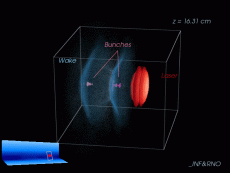Petawatt Laser Guiding and Electron Beam Acceleration to 8 GeV in a Laser-Heated Capillary Discharge Waveguide

Plasma waves (blue) excited by the PW BELLA laser pulse (red) as it propagates in a plasma channel. Background electrons are trapped and accelerated to an energy of up to 7.8 GeV in the plasma wave (pink/purple). Simulation performed with the ParticleInCell code INF&RNO (BLAST toolkit) on Edison.
Laser ‘Drill’ Sets a New World Record in Laser-Driven Electron Acceleration
Science Achievement
Researchers at Berkeley Lab’s BELLA Center set a new world record in laser-driven plasma-based electron acceleration by obtaining beams with an energy of up to 7.8 GeV in a 20 cm-long plasma using the high-power BELLA laser. The maximum achieved energy nearly doubled their previous record set in 2014. This result was made possible by the use of a new plasma target preparation technique where a “heater” laser pulse is used in combination with a discharge capillary to produce a deep enough plasma channel that is able to guide the BELLA laser over the 20 cm distance, corresponding to 15 diffraction lengths. Modeling of the heater laser dynamics and of the laser-plasma interaction physics played a central role in the success of the experiment.
Impact
Laser plasma accelerators are characterized by large acceleration gradients of tens to hundreds of GV/m, which are several orders of magnitude larger than in conventional radio frequency technology. This could allow for compact, low-cost, accelerators in a variety of applications, including free-electron lasers, Thomson sources, and electron-positron colliders with TeV energy.
Research Details
Efficient laser-plasma acceleration requires guiding a short and intense laser pulse in plasma over long distances (20 cm in this experiment), much longer than the characteristic laser diffraction length (~1.3 cm for the BELLA laser). If the laser remains guided, the amplitude of the plasma wave (or wake) that the laser generates remains high, and so a particle beam injected in this plasma wave can be continuously accelerated by the high fields associated with the wake.
Guiding of the laser pulse is achieved via a plasma channel, which confines a laser pulse in a similar way to an optical fiber. A capillary discharge is commonly used to create a plasma channel. However, achieving the right channel properties at the low plasma density required for high-energy beams is challenging. In this work, the plasma channel produced by the capillary discharge was modified by means of a nanosecond-long “heater” laser pulse that was used to locally heat the plasma, reduce the on-axis density, and increase the guiding strength of the plasma channel. This allowed for the production and acceleration of electron beams with quasi-monoenergetic peaks up to 7.8 GeV, double the energy that was previously demonstrated.
NERSC systems were used extensively to simulate the channel formation using the magneto-hydrodynamic code MARPLE and to model electron acceleration using the particle-in-cell code INF&RNO. These simulations were instrumental in understanding and optimizing the experiment. Modeling of the electron beam production and acceleration (requiring modeling the propagation of a petawatt laser pulse in a 20 cm plasma) was performed with the PIC code INF&RNO. Several tens of simulations (~50) were run in support of the experiment for a total of more than 15,000,000 hours. Depending on the resolution, the number of nodes used was between 40 and 100 (the simulation cost was 200,000 hours to 800,000 hours, respectively). Cost of the MHD simulations to model the plasma target formation was 300,000 hours.
Related Links
- A. J. Gonsalves et al., Phys. Rev. Lett. 122, 084801 (2019) doi.org/10.1103/PhysRevLett.122.084801
- LBNL Press Release on this topic: https://newscenter.lbl.gov/2019/02/25/laser-drill-sets-a-new-world-record-in-laser-driven-electron-acceleration
About NERSC and Berkeley Lab
The National Energy Research Scientific Computing Center (NERSC) is a U.S. Department of Energy Office of Science User Facility that serves as the primary high performance computing center for scientific research sponsored by the Office of Science. Located at Lawrence Berkeley National Laboratory, NERSC serves almost 10,000 scientists at national laboratories and universities researching a wide range of problems in climate, fusion energy, materials science, physics, chemistry, computational biology, and other disciplines. Berkeley Lab is a DOE national laboratory located in Berkeley, California. It conducts unclassified scientific research and is managed by the University of California for the U.S. Department of Energy. »Learn more about computing sciences at Berkeley Lab.







